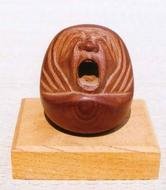:::::::::::::::::::::::::::::::::::::::::::::::::::::::::::::::::::::::::::::::::::::::::::::::::::::
Fudo Myo-O Gallery
:::::::::::::::::::::::::::::::::::::::::::::::::::::::::::::::::::::::::::::::::::::::::::::::::::::
Shaka Nyorai 釈迦如来 Gautama Buddha

. Seiryoojishiki Shaka 清凉寺式釈迦 .
Shaka Nyorai at temple Seiryoji in Saga, Kyoto
. pokkuri Shaka ポックリ釈迦 granting sudden death .
Introducing Buddha Statues
撫で仏と賓頭盧, びんずる、びんづる ビンヅル
Nadebotoke and Binzuru, the Arhat
:::::::::::::::::::::::::::::::::::::::::::::::::::::::::::::::::::::::::::::::::::::::::::::::::::::
Shaka Nehanzo Temple Anaoji
Kameoka City, Kyoto 穴太寺
京都府亀岡市曽我部町穴太東ノ辻46

© tatubou44 with more photos
The "Buddha entering Nirvana" (nehanzoo) is a kind of nadebotoke 撫で仏 and people come to touch and rub him on the part where their own pain is felt. Some got better and now send a futon cover for the statue. The head priest uses all the covers from so many people, a different every day sometimes, to keet the buddha from cold in winter and heat in summer.
If it is covered, you just turn away the futon and rub the statue at the place of your pain.
You can see his neck is quite cleanly rubbed.
Usually Binzurusama is the rubbed one, a Shaka lying down to be rubbed is very seldom, maybe the only one in Japan. But it is heartwarming to see people flock around him with their sincere wish to get better.
. . . CLICK here for Photos 釈迦涅槃像(撫で仏)!
Anao-ji is the 21st temple on the Saigoku Kannon pilgrimage.
In 962 the priest at the temple was shot by a local samurai. When the warrior entered the temple to steal the rich altar-fittings he found the statue of Kannon pierced with an arrow and bleeding from her breast. The samurai repented and went on to fund many of the temple's works. His grave is in the temple grounds.
source : www.taleofgenji.org
. . . CLICK here for English Photos !
:::::::::::::::::::::::::::::::::::::::::::::::::::::::::::::::::::::::::::::::::::::::::::::::::::::
Anaoji's wooden Gautama Buddha statue

© PHOTO : www.city.kameoka.kyoto.jp
:::::::::::::::::::::::::::::::::::::::::::::::::::::::::::::::::::::::::::::::::::::::::::::::::::::
:::::::::::::::::::::::::::::::::::::::::::::::::::::::::::::::::::::::::::::::::::::::::::::::::::::
16 Gute Gottheiten um einen Shakyamuni
(Juuroku Zenjin 十六善神)
16 Gute Gottheiten um die Statue eines Shaka Nyorai oder eine Shaka-Dreiergruppe. Je acht Statuen rechts und links. Sie haben besondere Kräfte, um den Menschen unmittelbar zur Erleuchtung zu verhelfen.
Als Bilder entweder jeweils acht oder zwei auf einer Rolle oder 16 Rollen, für jede Figur eine.
Beim Ritual der großen Hanya-Versammlung (Daihanya-e) werden vor diesen 16 Statuen die 600 Hanya-Sutrabände von sechs Priestern schnell fächerförmig aufgefaltet. Diese Hanya-Sutras sollen auch heilkräftige Wirkung haben und werden bei Krankheiten aufgestellt oder aufgelegt. In diesem Zusammenhang werden sie auch "Jünger des Daihanya-Sutra" (Daihanya juuroku zenjin) genannt.
Ikonografie:
Shaka 釈迦十六善神
16の夜叉神(やしゃじん) juuroku no yashajin
十二神将と四大天王
Meist die vier Himmelskönige und 12 weitere Ten-Statuen mit furchterregendem Gesichtsausdruck.
Sie tragen fast alle chinesische Rüstungen. Manche tragen Waffen. Einer hat eine Sutrarolle (Weisheit, hanya) auf dem Rücken. Dies sei Genjoo Sanzoo, der chinesische Mönch, der nach Indien wanderte und viele Sutras nach China zurückbrachte. Er ist der eigentliche Begründer der Hanya-Tradition.

Sie haben nach Tanaka folgende Bezeichnungen und tragen bestimmte Gegenstände:
..... Daitorada (Jikokuten) ..... - Zwei Arme; rechte Hand: großes Schwert, linke Hand: Dreizack.
..... Birurokusha (Zoochooten) ..... - Zwei Arme; rechte Hand: Donnerkeil, linke Hand: an der Hüfte liegend.
..... Saifuku Dokugai..... - Zwei Arme; Großes Schwert.
..... Zooyaku..... - Vier Arme; Großes Schwert, Schwert, Rad, Pilgerstab.
..... Kanki..... - Zwei Arme; Angelhaken mit einer Spitze; andere Hand an der Hüfte.
..... Shoitsu Saishoonan ..... - Sechs Arme; langer Stab mit drei Spitzen, Sutrenrolle, Reliquienpagode, rote Lotusblüte, Angelhaken, Schneckentrompete.
..... Batsujosaiku..... - Zwei Arme; Stab mit fünf Spitzen, Faust über dem Kopf erhoben.
..... Noonin..... - Zwei Arme; Großes Schwert, Hellebarde.
..... Fueshiramanu (Tamonten) ..... - Zwei Arme; Diamant-Pagode, Reliquienpagode.
..... Birubakusha (Koomokuten) ..... - Zwei Arme; Pinsel und Schreibrolle.
..... Riissai Fui ..... - Zwei Arme; Donnerkeil mit einem Zacken, Faust.
..... Kugoissai ..... - Zwei Arme; gefaltete Hände mit roter halboffener Lotusblüte.
..... Shoofuku Shoma ..... - Zwei Arme; Schwert, der andere Arm herunter~hängend.
..... Nooku Shoou..... - Zwei Arme; gefaltete Hände mit hervorstehenden Zeigefingern.
..... Shishi Imoo..... - Vier Arme; Axt, Schwert, Sutrenschatulle.
..... Yuumoo Shinchi..... - Zwei Arme.
堤頭ら宅(持国天)・毘楼勒叉(びるろくしゃ、増長天)・摧伏毒害(さいふくどくがい)・増益(ぞうやく)・歓喜(かんぎ)・除一切障難・抜除罪垢(ばつじょざいく)・能忍(のうにん)・吠室羅摩拏(べいしらまぬ、多聞天)・毘楼博叉(びるばくしゃ、広目天)・離一切怖畏(りいっさいふい)・救護一切(きゅうごいっさい)・摂伏諸魔(しょうふくしょま)・能救諸有(のうくしょうう)・師子威猛(ししいもう)・勇猛心地(ゆうもうしんじ)
Nach Ashida:
Daizurata, Birurokusha, Saibuku Dokugai, Zooyaku, Kanki, Joissai Joonan, Batsujo Zaiku, Noonin, Beishitsuramedo, Biruhasha, Riissai Fui, Kugoissai, Setsubuku Shoma, Nooku Shoou, Shishi Imiyoo, Yuumyoo Shinchi.
.Buddhastatuen ... Who is Who
Ein Wegweiser zur Ikonografie
von japanischen Buddhastatuen
Gabi Greve, 1994
English is here
16 Protectors of Shaka Nyorai
a specific group of warlike figures
. 16 Good Gods / Juroku Zenjin
:::::::::::::::::::::::::::::::::::::::::::::::::::::::::::::::::::::::::::::::::::::::::::::::::::::::
[ . BACK to DARUMA MUSEUM TOP . ]
[ . BACK to WORLDKIGO . TOP . ]
:::::::::::::::::::::::::::::::::::::::::::::::::::::::::::::::::::::::::::::::::::::::::::::::::::::::








